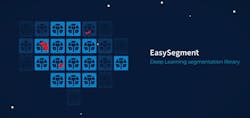Discover our Open eVision Deep Learning libraries to inspect and classify defects
Neural Networks are computing systems inspired by the biological neural networks that constitute the human brain. Convolutional Neural Networks (CNN) are a class of deep, feed-forward artificial neural networks, most commonly applied to analyzing images.
Deep Learning uses large CNNs to solve complex problems difficult or impossible to solve with so-called conventional computer vision algorithms. Deep Learning algorithms may be easier to use as they typically learn by example. They do not require the user to figure out how to classify or inspect parts. Instead, in an initial training phase, they learn just by being shown many images of the parts to be inspected. After successful training, they can be used to classify parts, or detect and segment defects.
EasyClassify
DEEP LEARNING CLASSIFICATION LIBRARYEasyClassify is the classification tool of Deep Learning Bundle. EasyClassify requires the user to label training images, that is to tell which ones are good and which ones are bad, or which ones belong to which class. After this learning/training process, the EasyClassify library is able to classify images. For any given image, it returns a list of probabilities, showing the likelihood that the image belongs to each of the classes it has been taught.For example, if the process requires setting apart bad parts from good ones, EasyClassify returns whether each part is good or bad, and with what probability.
At a glance
- Includes functions for classifier training and image classification
- Able to detect defective products or sort products into various classes
- Supports data augmentation, works with as few as one hundred training images per class
- Compatible with CPU and GPU processing
- Includes the free Deep Learning Studio application for dataset creation, training and evaluation
- Only available as part of the Deep Learning Bundle
EasySegment
DEEP LEARNING SEGMENTATION LIBRARY
EasySegment is the segmentation tool of Deep Learning Bundle. EasySegment performs defect detection and segmentation. It identifies parts that contain defects, and precisely pinpoints where they are in the image. The unsupervised mode of EasySegment works by learning a model of what is a “good” sample (i.e. a sample without any defect). This is done by training it only with images of “good” samples. Then, the tool can be used to classify new images as good or defective and segment the defects from these images. By training only with images of good samples, the unsupervised mode of EasySegment is able to perform inspection even when the type of defect is not known beforehand or when defective samples are not readily available.The supervised mode of EasySegment works by learning a model of what is a defect and what is a “good” part in an image. This is done by training with images annotated with the expected segmentation. Then, the tool can be used to detect and segment the defects in new images. The supervised mode of EasySegment achieves better precision and can segment more complex defects than the unsupervised mode thanks to the knowledge of the expected segmentation.
At a glance
- Unsupervised mode: train only with “good” images to detect and segment anomalies and defects in new images
- Supervised mode: learn a model of the defects for better segmentation and detection precision
- Works with any image resolution
- Supports data augmentation and masks
- Compatible with CPU and GPU processing
- Includes the free Deep Learning Studio application for dataset creation, training and evaluation
- Only available as part of the Deep Learning Bundle


